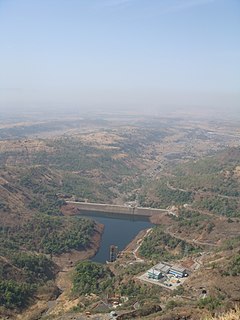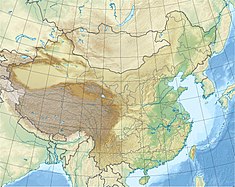
Silvan Dam is an embankment concrete-face rock-fill currently under construction on the Batman River in the district of Silvan, Diyarbakır Province in southeastern Turkey. It is part of the Southeastern Anatolia Project and located upstream of the Batman Dam. Construction began on 26 July 2011 and is expected to be complete in 2020. The purpose of the dam is hydroelectric power production and irrigation. It is designed to irrigate an area of 245,000 ha. The power station will have an installed capacity of 160 MW.

The Shuibuya Dam is a concrete-face rock-fill embankment dam on the Qingjiang River in Badong County, Enshi, Hubei Province, China. The purpose of the dam is mainly hydroelectricity but it also promotes flood control, navigation, tourism and fishery. At 233 m (764 ft) tall and containing 15,640,000 m3 (20,460,000 cu yd) of material, it is the tallest concrete face rock-fill dam in the world.

The Governor Ney Braga de Barros Hydroelectric Plant, formerly known as Segredo, is a dam and hydroelectric power plant on the Iguazu River near Segredo in Paraná, Brazil. It is the fourth dam upstream of the Iguazu Falls and was constructed between 1987 and 1991 while being inaugurated in 1992. The power station has a 1,260 megawatts (1,690,000 hp) capacity and is supplied with water by a concrete face rock-fill embankment dam.

The Governor Bento Munhoz da Rocha Netto Hydroelectric Plant, formerly known as Foz do Areia, is dam and hydroelectric power plant on the Iguazu River near Foz do Areia in Paraná, Brazil. It is the furthest dam upstream of the Iguazu Falls and was constructed between 1976 and 1980. The power station has a 1,676 megawatts (2,248,000 hp) capacity and is supplied with water by a concrete face rock-fill embankment dam.

The Machadinho Hydroelectric Power Plant is a dam and hydroelectric power plant on the Pelotas River near Machadinho on the border of Santa Catarina and Rio Grande do Sul, Brazil. The power station has a 1,140 MW (1,530,000 hp) capacity and is supplied with water by a concrete face rock-fill embankment dam. It is owned and operated by Machadinho Energetica and produces the equivalent of 37% of the energy consumed in Santa Catarina.

The Itumbiara Dam is an embankment dam on the Paranaíba River near Itumbiara in Goiás, Brazil. The dam serves an associated hydroelectric power plant with a 2,082 megawatts (2,792,000 hp) installed capacity. The power plant is the sixth largest in Brazil and has the largest installed capacity of Eletrobrás Furnas' power plants.

The Yele Dam is an embankment dam on the Nanya River along the border of Mianning County and Shimian County, Sichuan Province, China. It is 124.5 metres (408 ft) high and 411 metres (1,348 ft) long. Because the dam lies within a Level VIII earthquake intensity zone, its core is composed of asphalt concrete. Construction on the dam began in 2000, the reservoir began impounding on January 1, 2005 and the entire project was complete in August 2006. The purpose of the dam is to produce hydroelectricity and it supports a 240 MW power station. Water from the dam's reservoir is diverted into a 7.2 kilometres (4 mi) long headrace tunnel before reaching the power station.

The Guanyinyan Dam is a gravity dam on the Jinsha River 30 km (19 mi) southwest of Panzhihua on the border of Yunnan and Sichuan Provinces in China. The purpose of the dam is hydroelectric power generation and flood control. Construction on the dam started in 2008 and the river was diverted by 2010. The first generator was operational on 20 December 2014 and the fourth on 14 December 2015. The entire power station should be operational by 2016. When complete, the dam will support a 3,000 MW power station consisting of five 600 MW Francis turbine generators.

The Jishixia Dam is a concrete face rock-fill embankment dam on the Yellow River in Qinghai Province, China. It is 101 m (331 ft) tall and downstream from the Gongboxia Dam. The purpose of the dam is hydroelectric power generation and flood control. The dam supports a power station with 3 x 340 MW Francis turbines for a total installed capacity of 1,020 MW. Construction on the dam began in 2005 and the river was diverted in March 2007. The first generator was operational in mid-2010 and the rest by the end of the year.

The Wanjiazhai Dam is a gravity dam on the Yellow River on the border of Pianguan County, Shaanxi Province and Inner Mongolia Autonomous Region, China. The main purpose of the dam is water supply for the Wanjiazhai Water Control Project along with peak hydroelectric power generation. Construction on the dam began in 1994, the first generator went online in 1998 and the last in 2000.

The Lianghekou Dam is a concrete-face rock-fill dam currently under construction on the Yalong River in Yajiang County, Sichuan Province, China. The dam is located at the confluence of the Yalong, Xianshui and Qingda Rivers. The 295 m (968 ft) tall dam will be the highest embankment dam in the country and support a 3,000 MW power station. Studies for the dam were completed between 2005 and 2009 with preliminary construction beginning that year. Major works on the dam officially began in October 2014. The first generator is expected to be commissioned in 2021 and the project complete in 2023.

The Houziyan Dam(Chinese: 猴子岩水电站) is an under construction embankment dam on the Dadu River in Danba County, Sichuan province, China. When completed, the dam will be 223.5 m (733 ft) tall and withhold a reservoir with a normal capacity of 662,000,000 m3 (536,692 acre⋅ft). It will also support a power station with a 1,700 MW capacity; containing 4 x 425 MW generators.

The Bashan Dam is an embankment dam on the Renhe River located 15 km (9 mi) northwest of Chengkou County's seat in Chongqing, China. The primary purpose of the dam is hydroelectric power generation and it supports a 140 MW power station containing two 70 MW Pelton turbine-generators. It is a concrete-face rock-fill type with a height of 155 m (509 ft); creating a reservoir with a capacity of 315,000,000 m3 (412,004,445 cu yd). The dam is located before a bend in the river and diverts water through a 2,181 m (7,156 ft) long headrace tunnel that leads to the power station. Construction on the project began in 2005, the river was diverted by 2006 and the generators operational in 2009.

The Longshou II Dam, also referred to as Longshou No. 2, is a concrete-face rock-fill dam on the Heihe River, located 35 km (22 mi) southwest of Zhangye in Gansu Province, China. It is part of the Gansu Heihe Rural Hydropower Development and supports a 157 MW power station. The dam's first feasibility study was carried out in 2000 and river diversion construction began in December 2001. In June 2002, the river was diverted and in September that year, filling of the dam's body began. On 17 August 2004, the first generator was operational with the rest by the end of the year. The 146.5 m (481 ft) high dam withholds a reservoir with a capacity of 86,200,000 m3 (69,883 acre⋅ft). It's spillway is located on the right bank and is a controlled chute type with a discharge capacity of 2,696 m3/s (95,208 cu ft/s). Water is delivered to the dam's power station downstream via a 1.7 km (1 mi) long tunnel. The dam is located upstream of the Longshou I Dam, an 80 m (262 ft) tall double-curvature arch dam with an installed capacity of 52 MW. Upstream is the Xiaogushan Dam, a gravity dam which diverts water to a 102 MW power station.

The Daguangba Dam is a multi-purpose dam on the Changhua River in Hainan Province, China. It is located 35 km (22 mi) east of Dongfang. As the primary component of the Daguangba Multipurpose Project, the dam was constructed between 1990 and 1995. It serves to provide water for both hydroelectric power generation and agriculture. It supports a 240 MW power station and supplies water for the irrigation of 12,700 ha. It is also the largest dam and hydroelectric power station in Hainan.

Ghatghar Dam refers to two associated gravity dams built using roller-compacted concrete, the first use in India. They are situated in Ghatghar village in Ahmednagar district Maharashtra, India. Both dams create a lower and upper reservoir for the 250 MW pumped-storage hydroelectric power station. The upper Ghatghar dam is 15 m (49 ft) tall and on the Pravara River, a tributary of Godavari river. The lower Ghatghar dam is 86 m (282 ft) tall and located on the Shahi Nalla which is a tributary of Ulhas River to the south west of the upper reservoir in a steep valley. The hydro power project diverts Godavari river basin water outside the basin area to a west flowing river of Western ghats.

The Lubuge Dam is a rock-fill embankment dam on the Huangni River, a tributary of the Nanpan River, located near Lubugexiang in Luoping County on the border of Guizhou and Yunnan Provinces, China. The primary purpose of the dam is hydroelectric power generation and it supports a 600 MW power station. Construction on the project began in 1982 and it was completed in 1991. Funded by the World Bank, it was the first loan offered by the bank to China's power sector.

The Jinpen Dam is a rock-fill embankment dam on the Heihe River, a tributary of the Weihe River which flows into the Yellow River, in Zhouzhi County of Shaanxi Province, China. It serves as a multi-purpose dam; providing water for irrigation and municipal uses while also affording flood control and hydroelectric power generation. Water from the reservoir is used to irrigate crops in the Weihe River valley just below the dam. Along with the Shitouhe Dam to the west, the dam supplies the nearby city of Xi'an with municipal water. The power station at the dam has an installed capacity of 25 MW. Construction on the dam began in 1998 and the river was diverted in 1998. Filling of the reservoir began in 2000 and was complete in 2001. The power station was commissioned by 2002.

The Maerdang Dam is a concrete-face rock-fill dam currently under construction on the Yellow River in Maqên County, Qinghai Province, China. Construction on the dam began in 2011 and its 2,200 MW power station is expected to be operational in 2018. On 13 November 2013, the river was successfully diverted around the construction site.

The Gongguoqiao Dam is a gravity dam on the Lancang (Mekong) River in Yunlong County of Yunnan Province, China. The primary purpose of the dam is hydroelectric power generation. Construction began in 2008 and the river was diverted around the dam site in 2009. The next year concrete placement began and in 2011 the first generator was commissioned. The 900 MW power station was fully operational on 21 June 2012.











